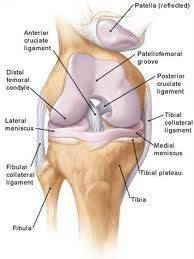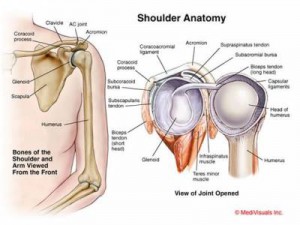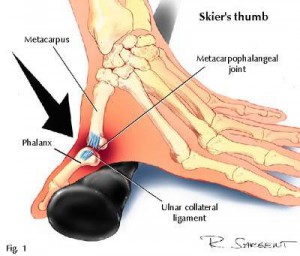
Knees
The knee is the most commonly injured joint when skiing and it is usually ligaments that take the strain.
The medial collateral ligament (MCL) on the inside of the knee is the most frequently injured ligament. It usually occurs with a twisting fall, often at slow speed when the ski bindings don’t release. Early physiotherapy and use of a brace is usually successful in treating MCL injuries.
The anterior cruciate ligament (ACL) is a more serious injury as this usually completely ruptures unlike the MCL. It is usually the result of a shearing force where the shin moves forward on the thigh bone during a fall. An ACL rupture often requires surgery to repair the torn ligament followed by extensive physiotherapy to restore movement, strength and function.
Meniscus or cartilage tears can also occur with skiing, often at the same time as ligament injuries. The meniscus tears when a skier falls with a twisting motion on a bent knee. Depending on the severity of the tear, surgery may be required to tidy up the torn portion and prevent the knee joint from locking. However, good physiotherapy can often restore full, pain-free function to a knee with a torn meniscus.
How PPASIC can Help Prevent and Treat Knee Injuries

- Pre-skiing quads (thigh muscles) strengthening exercises to support and protect the knee joint
- Balance/proprioception exercises to help prevent falls
- Advice on how to fall properly without twisting the knee and to ensure your ski bindings aren’t too tight
- RICE – rest, ice, compression, elevation and electrotherapy to reduce swelling and inflammation
- Mobilisations to restore full range of movement
- A graduated exercise programme to restore full strength and function
Shoulders
There are four main shoulder injuries seen in skiers.
Dislocations occur following a fall onto an outstretched hand whilst twisting the shoulder. A dislocation is confirmed on X-ray and the skier will be supporting the arm and in a lot of pain. It is essential to reduce the shoulder (put it back in place) as soon as possible by someone qualified to do it! It will give instant pain relief but the shoulder should then be immobilised in a sling.
Clavicle (collar bone) fractures are also the result of a fall onto an outstretched arm where the impact travels up the arm to the collar bone. A visible, painful lump can be felt along the clavicle. As with dislocations, the arm should be immobilised in a sling for a couple of weeks. Fractured clavicles usually heal well but occasionally require surgery if the bone ends are severely displaced.
AC Joint injuries. The acromioclavicular (AC) joint is at the outside edge of the shoulder and is a small joint between the clavicle and the shoulder blade. A fall causing direct impact onto the top of the arm can damage the ligament holding the two bones together. A severe sprain will cause separation on the two bones leading to a visible, painful lump.
A fractured humerus (upper arm bone) can also occur with direct impact or sometimes a fall onto an outstretched hand. The diagnosis is confirmed with an X-ray but doesn’t usually need surgery but should be rested in a sling followed by physiotherapy.
How PPASIC can Help Prevent and Treat Shoulder Injuries
 Pre-skiing shoulder stabilising and strengthening programme
Pre-skiing shoulder stabilising and strengthening programme- Advice on maintenance exercises whilst in the sling
- Mobilisations to restore range of movement
- Soft tissue release techniques to stretch tight muscles and ligaments
- Graduated programme of mobilising, strengthening and stabilising exercises to restore full function.
Thumbs
 Skiers thumb is a common injury that is often mis-diagnosed and under-treated. It is a sprain (or rupture) of the ligament at the base of the thumb which occurs when a skier falls whilst holding their pole. This can force the thumb outwards, away from the fingers, tearing the ligament. This injury can be very debilitating if not treated correctly, as the thumb is extremely important in grip strength and hand function.
Skiers thumb is a common injury that is often mis-diagnosed and under-treated. It is a sprain (or rupture) of the ligament at the base of the thumb which occurs when a skier falls whilst holding their pole. This can force the thumb outwards, away from the fingers, tearing the ligament. This injury can be very debilitating if not treated correctly, as the thumb is extremely important in grip strength and hand function.
How PPASIC can Help Prevent and Treat Thumb Injuries
- Advice to ski without wrapping the pole straps round the wrist – the skier will drop the pole so avoiding injuring the thumb. You may lose the pole but it’s better than a serious thumb injury!
- Splinting or taping to support the injured ligament
- Mobilisations to restore full movement
- Functional exercises to restore hand function
Head
Head injuries have had much media attention recently after the tragic death of Natasha Richardson and life-changing injuries to Michael Schumacher. They are caused by collision, usually at high speed, with a stationary object such as a tree or pylon, another person or a fall backwards onto hard snow. Head injuries range in severity from a painful bump and mild headache to severe, permanent brain damage or death.
At PPASIC we are not neurological physiotherapists and, given the potentially serious implications, it would not be appropriate for us to treat head injuries. We could refer a head injury patient to other local neurological physiotherapists.
However, as a preventative measure we would always recommend skiers to wear a helmet.
For further information on skiing injuries or to book an injury assessment please call us on 01730 267645 or contact us through our website.

Recent Comments